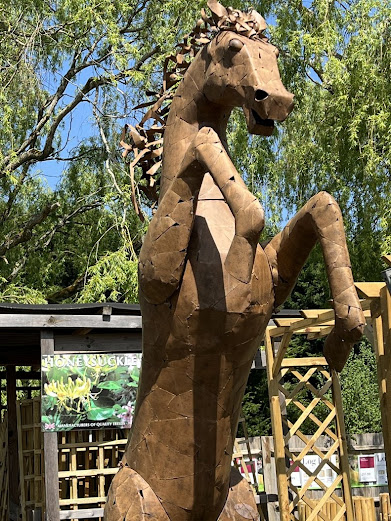Agility
Course
Watching dogs
speed around an agility course is pure delight, particularly if they make the
course their own, and run under obstacles instead of over them, or miss them
out completely. Some dogs are natural comedians and respond to laughter, and
they are the ones who steal the hearts of an audience.
We had a
liver and white Dalmatian called Buddy, who was actually rather good at agility.
He had brains and beauty, and wanted always to please his young owner, our
youngest daughter, Bethan. She had spent a great deal of time building agility courses
in our not very large garden, for Cariadd, our first Dalmatian. Bethan was
three years old when we brought the small, warm puppy home, so Cariadd was around
six when she started training her in agility. Cariadd was very obliging, but it
wasn’t really her favourite occupation. She preferred cross country running.
Buddy was a different prospect. He would do
anything for Bethan and did well in his classes. However, he was just too big to
compete with the dainty little dogs that normally excel at agility and
eventually the lessons ceased, and he reverted to being a proper Dalmatian,
running miles every day with Barry, Cariadd and Dominie.
We have
an agility course in our house. The objective is not to discover how fast we
can complete the course, but to see if we can complete it without breaking our
necks.
The first
obstacles are the slow-moving, indolent cats, who weave their way slightly
ahead of us, miaouing if we dare to suggest they could move a little faster,
please. Every move towards the kitchen indicates to them that meals might soon
be served. They have been heavily influenced by the dogs, whose major loves in
life are us, followed swiftly by food. The rule is, ‘If the humans move, we move,
too.’
Having negotiated
a track past the cats, the major obstacle presents itself. This is Roxy, who prostrates
herself before us like a living sacrifice. It is imperative that she is never more
than twelve inches away from one of us. I fear that she suffers from the
reverse ostrich syndrome; that is, if we cannot see her, we might deny her
existence.
Preparing
meals, filling the kettle, emptying the dishwasher/washing machine/tumble dryer,
packing the groceries away in fridge, freezer or cupboard, Roxy is always there,
at our feet. I don’t know how we don’t trip over her.
Gilbert is
also part of the course, but his function is to help. He moves around us, bringing
us toys if he thinks we need some encouragement in our pursuits.
When we
have completed whatever footling task we embarked on, we retreat from the
kitchen, but now the agility course has been altered. The recumbent Roxy has
miraculously and silently blocked our way out of the kitchen. It would not be
advisable to step over her, because she has been known to rise up, mid-step-over,
and that is quite hazardous. Slowly, we navigate our path back, accompanied by
our four-footed friends.
Nothing
can be accomplished at speed in our house unless we shut the animals away. Hence,
we have baby gates at strategic doorways, behind which dogs can be contained. They
don’t work for the cats – they slither under or leap over. The gates mean that
the dogs can still be in contact, but not as closely as they might desire.
It's not
so vastly different to having toddlers and at least the animals don’t have
tantrums.


_(3807216061).jpg)










